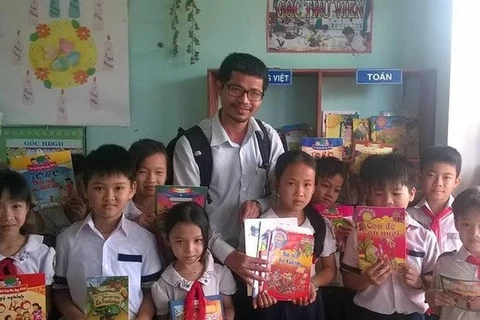 Mong ethnic minority people attend a counter-illiteracy class in Sang Tung commune, Ha Giang province's Dong Van district (Photo: VNA)
Mong ethnic minority people attend a counter-illiteracy class in Sang Tung commune, Ha Giang province's Dong Van district (Photo: VNA) Hanoi (VNA) – Strides have been made in Vietnam to eradicate illiteracy over the last seventy years, and efforts to promote literacy continue today.
Vietnam met the national standard for literacy in 2000, with 94 percent of the population aged between 15 and 35 literate, compared to more than 95 percent of the population unable to read or write in 1945, when it gained independence.
The literacy rate has reached 98.1 percent in the 15-35 age group and 96.83 percent in the 15-60 age group, according to a report on the 2015-2016 academic year compiled by the Ministry of Education and Training (MoET).
Cities directly subordinate to the central government and the provinces in the Red River Delta and the northern central region performed best in tackling illiteracy.
Up to 99.99 percent of residents aged between 15 and 60 in the Red River Delta province of Thai Binh know how to read and write, with the rough figure in nearby Hai Duong 99.9 percent, Ha Nam 99.95 percent and Nam Dinh 99.95 percent, and central Da Nang city 99.9 percent.
However, there remain those who could not even sign their names, mainly in northern mountainous, Central Highlands and Mekong Delta provinces. They account for 17.29 percent of the population in Lai Chau; 17.79 percent in Ha Giang; 6.38 percent in Gia Lai, 5.17 percent Dak Lak; 8.44 percent in Tra Vinh; and 4.7 percent in Long An.
Most of the illiterate are ethnic minority people, who account for 44.8 percent of the total illiterate people nationwide, MoET data showed.
Widespread domestic efforts
 A border guard teaches residents how to read and write in the Central Highlands province of Dak Lak (Photo: VNA)
A border guard teaches residents how to read and write in the Central Highlands province of Dak Lak (Photo: VNA) Vietnam has taken moves to make its illiteracy eradication efforts productive, said Nguyen Cong Hinh – Director of the MoET’s Department of Continuing Education.
About 11,060 community-based learning centres across the country have been working together in tackling illiteracy, he said, elaborating that they have opened classes and launched diverse learning activities to help learners develop their reading and writing skills and use them to transform their lives.
In 2013, a scheme on stamping out illiteracy in the country by 2020 was developed and approved by the then Prime Minister Nguyen Tan Dung. It aims to raise the literacy rate among the 15-60 age group to 98 percent by 2020.
To actualise the scheme, specific illiteracy elimination plans have been devised for each province by localities and the MoET, Hinh said.
The MoET has stepped up reforming teaching methods, especially by using the Regenerated Freirean Literacy through Empowering Community Techniques (REFLECT) for areas with high illiteracy rates, including the northern mountainous, Central Highlands and Mekong Delta areas.
It has partnered with the education promotion association, the farmers’ union, the women’s union, and the youth union to engage every resource in illiteracy eradication.
“While intensive training in knowledge and teaching methods has been given to both full-time and part-time teachers, more classes have been opened for disadvantaged people like ethnics, the disabled and prisoners, to enable their access to knowledge,” Hinh noted.
The education sector has also diversified learning activities at community-based learning centres to attract local residents and prevent illiteracy relapses, he said.
Cooperation with foreign partners
Vietnam’s accomplishments in the domain were partly attributed to the assistance of international organisations, Hinh said, highlighting the “Strategic Development of Literacy Initiative for Empowerment Resource Support System” project.
With UNESCO support, the project was carried out across all 63 provinces and cities from November 2006 to December 2008, aiding the MoET and the localities in developing community-based learning and continuing education, providing training for counter-illiteracy workers, and compiling textbooks on different topics to help learners promote their skills.
Meanwhile, the REFLECT programme, an approach to eliminate illiteracy, has been implemented in Vietnam by ActionAid and the MoET since 2000. It combines the teaching of literacy skills with what learners are interested in and what applies to their lives, making lessons more attractive and effective.
This programme has been piloted in provinces with high illiteracy rates such as Dien Bien, Son La, Ha Giang, Ha Tinh, Ninh Thuan, Tra Vinh, and Soc Trang, the Director of the Continuing Education Department said.
He also underlined the partnership with the Japan International Cooperation Agency, which, through the National Federation of UNESCO Associations in Japan, supported an illiteracy reduction project targeting adults in northern mountainous areas.
International recognition
Vietnam’s decades-long efforts in illiteracy elimination have been lauded by the international community, as seen through the UNESCO literacy prizes presented in 1978, 1979, 1980, 1983, 1985, 1988 and 1997.
This year, the country will be honoured as UNESCO has decided to award a programme on bringing books to rural areas in Vietnam with the King Sejong International Literacy Prize.
The award presentation was held at the same time as the global celebration of the 50th International Literacy Day at UNESCO Headquarters in Paris on September 8.-VNA

























